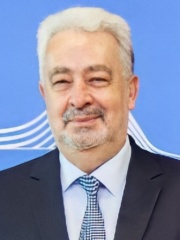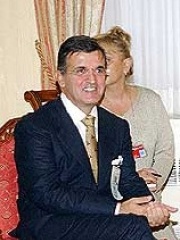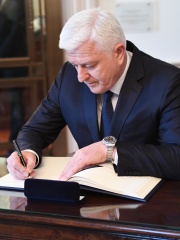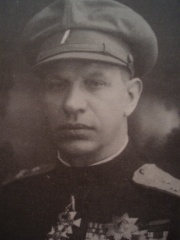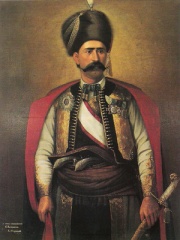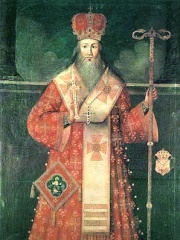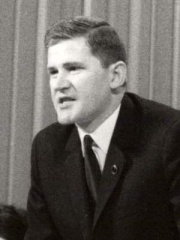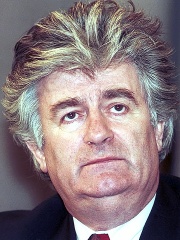
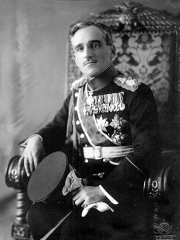

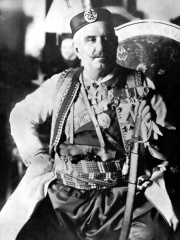

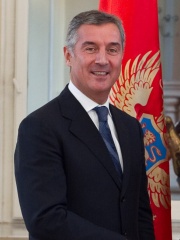
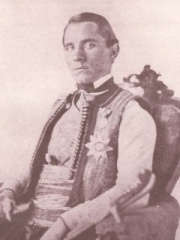
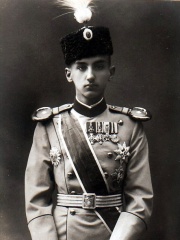
The Most Famous
POLITICIANS from Montenegro
This page contains a list of the greatest Montenegrin Politicians. The pantheon dataset contains 15,577 Politicians, 22 of which were born in Montenegro. This makes Montenegro the birth place of the 98th most number of Politicians behind Luxembourg and Kyrgyzstan.
Top 10
The following people are considered by Pantheon to be the top 10 most legendary Montenegrin Politicians of all time. This list of famous Montenegrin Politicians is sorted by HPI (Historical Popularity Index), a metric that aggregates information on a biography’s online popularity. Visit the rankings page to view the entire list of Montenegrin Politicians.

1. Radovan Karadžić (1945 - )
With an HPI of 73.80, Radovan Karadžić is the most famous Montenegrin Politician. His biography has been translated into 69 different languages on wikipedia.
Radovan Karadžić (Serbian Cyrillic: Радован Караџић, pronounced [râdoʋaːn kâradʒitɕ]; born 19 June 1945) is a Bosnian Serb politician who was convicted of genocide, crimes against humanity and war crimes by the International Criminal Tribunal for the former Yugoslavia (ICTY). He was the president of Republika Srpska during the Bosnian War. Trained as a psychiatrist, he co-founded the Serb Democratic Party in Bosnia and Herzegovina and served as the first president of Republika Srpska from 1992 to 1996. He was a fugitive from 1996 until July 2008, after having been indicted for war crimes by the ICTY. The indictment concluded there were reasonable grounds for believing he committed war crimes, including genocide against Bosniak and Croat civilians during the Bosnian War (1992–1995). While a fugitive, he worked at a private clinic in Belgrade, specializing in alternative medicine and psychology, under an alias. He was arrested in Belgrade in 2008 and brought before Belgrade's War Crimes Court a few days later. Extradited to the Netherlands, he was placed in the custody of the ICTY in the United Nations Detention Unit of Scheveningen, where he was charged with 11 counts of war crimes and crimes against humanity. He is sometimes referred to by the Western media as the "Butcher of Bosnia", a sobriquet also applied to former Army of Republika Srpska (VRS) General Ratko Mladić. In 2016, he was found guilty of the genocide in Srebrenica, war crimes, and crimes against humanity, 10 of the 11 charges in total, and sentenced to 40 years' imprisonment. In 2019, an appeal he had filed against his conviction was rejected, and the sentence was increased to life imprisonment. In 2021, it was announced that he would be transferred to a British prison.

2. Alexander I of Yugoslavia (1888 - 1934)
With an HPI of 69.58, Alexander I of Yugoslavia is the 2nd most famous Montenegrin Politician. His biography has been translated into 48 different languages.
Alexander I (Serbo-Croatian: Aleksandar I Karađorđević / Александар I Карађорђевић, pronounced [aleksǎːndar př̩ʋiː karad͡ʑǒːrd͡ʑeʋit͡ɕ]; 16 December 1888 [O.S. 4 December] – 9 October 1934), also known as Alexander the Unifier, was King of the Serbs, Croats and Slovenes from 16 August 1921 to 3 October 1929 and King of Yugoslavia from 3 October 1929 until his assassination in 1934. His reign of 13 years is the longest of the three monarchs of the Kingdom of Yugoslavia. Born in Cetinje, Montenegro, Alexander was the second son of Peter and Zorka Karađorđević. The Karađorđević dynasty had been removed from power in Serbia 30 years prior, and Alexander spent his early life in exile with his father in Montenegro and then Switzerland. Afterwards he moved to Russia and enrolled in the imperial Page Corps. Following a coup d'état and the murder of King Alexander I Obrenović in 1903, his father became king of Serbia. In 1909, Alexander's elder brother, George, renounced his claim to the throne, making Alexander heir apparent. Alexander distinguished himself as a commander during the Balkan Wars, leading the Serbian army to victory over the Ottomans and the Bulgarians. In 1914, he became prince regent of Serbia. During the First World War, he held nominal command of the Royal Serbian Army. In 1918, Alexander oversaw the unification of Serbia and the former Austrian provinces of Bosnia, Croatia and Slovenia into the Kingdom of Serbs, Croats and Slovenes. He ascended to the throne upon his father's death in 1921. An extended period of political crisis followed, culminating in the assassination of Croat leader Stjepan Radić. In response, Alexander abrogated the Vidovdan Constitution in 1929, prorogued the parliament, changed the name of the country to Kingdom of Yugoslavia and established a royal dictatorship. The 1931 Constitution formalised Alexander's personal rule and confirmed Yugoslavia's status as a unitary state, further aggravating the non-Serb population. Policital and economic tensions escalated on the outbreak of the Great Depression, which devastated the predominantly rural country. In foreign affairs, Alexander supported the Balkan Pact with Greece, Romania and Turkey, and sought to improve relations with Bulgaria. In 1934, Alexander embarked on a state visit to France in order to secure support for the Little Entente against Hungarian revanchism and Italy's imperialist designs. During a stop in Marseille, he was assassinated by Vlado Chernozemski, a member of the pro-Bulgarian Internal Macedonian Revolutionary Organization, which received assistance from the Croat Ustaše led by Ante Pavelić. French Foreign Minister Louis Barthou also died in the attack. Alexander was succeeded by his eleven-year-old son, Peter II, under the regency of his first cousin Prince Paul.

3. Stefan Nemanja (1113 - 1199)
With an HPI of 66.65, Stefan Nemanja is the 3rd most famous Montenegrin Politician. His biography has been translated into 37 different languages.
Stefan Nemanja (Serbian Cyrillic: Стефан Немања, pronounced [stêfaːn ně̞maɲa]; c. 1113 or 1114 – 20 February 1199) was the Grand Prince (Veliki Župan) of the Serbian Grand Principality (also known as Raška, lat. Rascia) from 1166 to 1196. A member of the Vukanović dynasty, Nemanja founded the Nemanjić dynasty, and is remembered for his contributions to Serbian culture and history, founding what would evolve into the Serbian Empire, as well as the national church. According to the Serbian Academy of Sciences and Arts, Nemanja is also among the most remarkable Serbs for his literary contributions and altruistic attributes. In 1196, after three decades of warfare and negotiations, including the Third Norman invasion of the Balkans (1185–1186) which consolidated Serbia while distinguishing it from both Western and Byzantine spheres of influence, Nemanja abdicated in favour of his middle son Stefan Nemanjić, who later became the first King of Serbia. Nemanja ultimately went to Mount Athos, where he became a monk and took the name of Simeon, joining his youngest son (later known as Saint Sava), who had already become the first archbishop of the Serbian Orthodox Church. Together with his son Saint Sava, Nemanja restored the Hilandar Monastery at Mount Athos from 1198 to 1199, and issued the "Charter of Hilandar". The monastery thus became the center of Serbian Orthodox monasticism at Athos. Shortly after his death, Serbian Orthodox Church canonized Stefan Nemanja, under the name Saint Simeon the Myroblyte (Serbian: Свети Симеон Мироточиви).

4. Nicholas I of Montenegro (1841 - 1921)
With an HPI of 65.67, Nicholas I of Montenegro is the 4th most famous Montenegrin Politician. His biography has been translated into 39 different languages.
Nikola I Petrović-Njegoš (Serbian Cyrillic: Никола I Петровић-Његош; 7 October [O.S. 25 September] 1841 – 1 March 1921) was the last monarch of Montenegro from 1860 to 1918, reigning as prince from 1860 to 1910 and as the country's first and only king from 1910 to 1918. His grandsons were kings Alexander I of Yugoslavia and Umberto II of Italy among others.
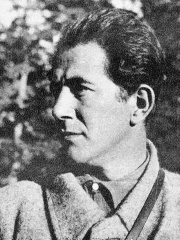
5. Milovan Đilas (1911 - 1995)
With an HPI of 62.81, Milovan Đilas is the 5th most famous Montenegrin Politician. His biography has been translated into 39 different languages.
Milovan Djilas (English: ; Serbian: Милован Ђилас, Milovan Đilas, pronounced [mîlɔʋan dʑîlaːs]; 12 June 1911 – 20 April 1995) was a Yugoslav communist politician, theorist and author. He was a key figure in the Partisan movement during World War II, as well as in the post-war government. A self-identified democratic socialist, Djilas became one of the best-known and most prominent dissidents in Yugoslavia and all of Eastern Europe. During an era of several decades, he critiqued communism from the viewpoint of trying to improve it from within; after the revolutions of 1989 and the violent breakup of Yugoslavia, he critiqued it from an anti-communist viewpoint of someone whose youthful dreams had been disillusioned.

6. Hersekzade Ahmed Pasha (1459 - 1517)
With an HPI of 61.84, Hersekzade Ahmed Pasha is the 6th most famous Montenegrin Politician. His biography has been translated into 22 different languages.
Hersekzade or Hersekli Ahmed Pasha ("Ahmed Pasha, son of the Herzog"; Serbo-Croatian: Ahmed-paša Hercegović; Aхмед-паша Херцеговић; 1456 – 21 July 1517), born as Stjepan Hercegović, he was the youngest son of the Herceg Stjepan Vukčić. Between late 1473 and early 1474 he departed from Novi (today Herceg Novi) to Istanbul, where he adopted Islam along with the peculiar way of life of the Ottoman court, which made possible his advancement through the Ottoman government and military ranks, eventually occupying top offices of the Empire's government and military as a statesman and navy's grand admiral.

7. Milo Đukanović (1962 - )
With an HPI of 58.93, Milo Đukanović is the 7th most famous Montenegrin Politician. His biography has been translated into 54 different languages.
Milo Đukanović (Montenegrin Cyrillic: Мило Ђукановић, pronounced [mǐːlo dʑǔkanoʋitɕ] ; born 15 February 1962) is a Montenegrin politician who served as the President of Montenegro from 2018 to 2023, previously serving in the role from 1998 to 2002. He also served as the Prime Minister of Montenegro (1991–1998, 2003–2006, 2008–2010 and 2012–2016) and was the long-term president of the Democratic Party of Socialists of Montenegro, originally the Montenegrin branch of the League of Communists of Yugoslavia, which governed Montenegro alone or in a coalition from the introduction of multi-party politics in the early 1990s until its defeat in the 2020 parliamentary election. He is the longest-ruling contemporary politician in Europe, having held key positions in the country for over 33 years. However, he was defeated by the 36-year-old centrist former economy minister, Jakov Milatović, after the presidential run-off held on 2 April 2023. When Đukanović first emerged on the political scene, he was a close ally of Slobodan Milošević during the anti-bureaucratic revolution (1988–1989) and the dissolution of SFR Yugoslavia (1991–1992). His cabinet actively participated in the siege of Dubrovnik (1991–1992). Đukanović supported Momir Bulatović's agreement on Lord Carrington's terms, which resulted in the 1992 Montenegrin independence referendum, where voters decided to remain in FR Yugoslavia. In 1996, however, Đukanović distanced himself from Milošević and the federal government, abandoning the traditional joint Serbian and Montenegrin vision in favour of Montenegrin nationalism, which supported state independence and a separate Montenegrin identity. That led to the division of the party and the split of Bulatović's pro-unionist faction. Shortly afterward, Đukanović defeated Bulatović in the 1997 presidential election by a thin margin. In 1999, he negotiated with Western countries in an attempt to limit airstrikes in Montenegro during the NATO bombing of Yugoslavia, while later Đukanović oversaw the implementation of the Deutsche Mark as the new currency in Montenegro, replacing the Yugoslav dinar. Following the overthrow of Milošević (2000), he signed an agreement with the new Serbian government that led to the Constitutional Charter of Serbia and Montenegro (2003), which allowed for Montenegrin independence. Three years later, the 2006 independence referendum led to a formal separation from the state union and the proclamation of the new Constitution of Montenegro (2007). Đukanović has pursued NATO and EU accession policy, resulting in Montenegro's NATO membership in 2017. Over the course of his premiership and presidency, he oversaw the privatization of public companies to foreign investors and firms. Several corruption scandals of the ruling party triggered 2019 anti-government protests, while a controversial religion law sparked another wave of protests. For the first time in three decades, in the 2020 parliamentary election, the opposition won more votes than Đukanović's ruling party and its partners. Some observers have described Đukanović's rule as authoritarian or autocratic, as well as a kleptocracy. His brother Aco Đukanović, the owner of Montenegro's first private bank, had the upper hand in privatisations, while his sister, the lawyer Ana Kolarevic, controlled the judiciary for a long time. DPS clientelist networks dominated all segments of social life, making party membership necessary to start a business or obtain a position in the administration. In 2020, the Freedom House classified Montenegro as a hybrid regime rather than a democracy, mentioning the years of increasing state capture, abuse of power, and strongman tactics employed by Đukanović. He is often described as having strong links to the Montenegrin mafia. Đukanović was listed among the twenty richest world leaders according to the British newspaper The Independent in May 2010, which described the source of his estimated £10 million wealth as "mysterious". In October 2021, Đukanović and his son Blažo were mentioned in Pandora Papers, linking them to two trusts on British Virgin Islands.

8. Danilo I, Prince of Montenegro (1826 - 1860)
With an HPI of 58.67, Danilo I, Prince of Montenegro is the 8th most famous Montenegrin Politician. His biography has been translated into 24 different languages.
Danilo I Petrović-Njegoš (Serbian Cyrillic: Данило I Петровић-Његош; 25 May 1826 – 13 August 1860) was the ruling Prince of Montenegro from 1851 to 1860. The beginning of his reign marked the transition of Montenegro from a traditional theocratic form of government (Prince-Bishopric) into a secular Principality. He became involved in a war with the Ottoman Empire in 1852, the Porte claiming jurisdiction in Montenegro, and the boundaries between the two countries were not defined until 1858. Danilo, with the help of his elder brother, Voivode Mirko, defeated the Ottomans at Ostrog in 1853 and in the Battle of Grahovac in 1858. The town of Danilovgrad is named after him.

9. George, Crown Prince of Serbia (1887 - 1972)
With an HPI of 57.90, George, Crown Prince of Serbia is the 9th most famous Montenegrin Politician. His biography has been translated into 19 different languages.
George, Crown Prince of Serbia (Serbian: Ђорђе Карађорђевић / Đorđe Karađorđević; 8 September (O.S. 27 August) 1887 – 17 October 1972), was the eldest son of King Peter I of Serbia and his wife, the former Princess Ljubica of Montenegro. He was the older brother of King Alexander I of Yugoslavia. In 1909, Crown Prince George killed his servant, and following a negative campaign in the press, he was compelled to give up his claim to the throne. He later served with distinction in the army, was severely wounded during the First World War, and thereby became popular in the country, which aroused the alarm of his younger brother. In 1925, his brother, the King, had him arrested, declared insane, and locked in an asylum. He remained confined there for nearly two decades, until released by the German occupying force during World War II. After that war ended, he was the only member of the royal family not to be sent into exile and declared an enemy of the state.
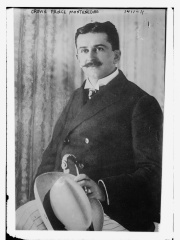
10. Danilo, Crown Prince of Montenegro (1871 - 1939)
With an HPI of 56.82, Danilo, Crown Prince of Montenegro is the 10th most famous Montenegrin Politician. His biography has been translated into 19 different languages.
Danilo Aleksandar Petrović-Njegoš (Serbian Cyrillic: Данило Александар Петровић-Његош; 29 June 1871– 24 September 1939) was the Crown Prince of Montenegro. He was the eldest son of King Nicholas I of Montenegro and Queen Milena Vukotić.
Pantheon has 22 people classified as politicians born between 1113 and 1976. Of these 22, 8 (36.36%) of them are still alive today. The most famous living politicians include Radovan Karadžić, Milo Đukanović, and Zdravko Krivokapić. The most famous deceased politicians include Alexander I of Yugoslavia, Stefan Nemanja, and Nicholas I of Montenegro. As of April 2022, 2 new politicians have been added to Pantheon including Zdravko Krivokapić and Branko Kostić.
Living Politicians
Go to all Rankings
Radovan Karadžić
1945 - Present
HPI: 73.80
Milo Đukanović
1962 - Present
HPI: 58.93
Zdravko Krivokapić
1958 - Present
HPI: 54.77
Svetozar Marović
1955 - Present
HPI: 51.50
Duško Ivanović
1957 - Present
HPI: 50.15
Duško Marković
1958 - Present
HPI: 47.32
Žarko Paspalj
1966 - Present
HPI: 44.28
Igor Lukšić
1976 - Present
HPI: 39.32

Deceased Politicians
Go to all Rankings
Alexander I of Yugoslavia
1888 - 1934
HPI: 69.58
Stefan Nemanja
1113 - 1199
HPI: 66.65
Nicholas I of Montenegro
1841 - 1921
HPI: 65.67
Milovan Đilas
1911 - 1995
HPI: 62.81
Hersekzade Ahmed Pasha
1459 - 1517
HPI: 61.84
Danilo I, Prince of Montenegro
1826 - 1860
HPI: 58.67
George, Crown Prince of Serbia
1887 - 1972
HPI: 57.90
Danilo, Crown Prince of Montenegro
1871 - 1939
HPI: 56.82
Radola Gajda
1892 - 1948
HPI: 55.28
Mirko Petrović-Njegoš
1820 - 1867
HPI: 53.23
Arsenije III Čarnojević
1633 - 1706
HPI: 52.92
Branko Kostić
1939 - 2020
HPI: 52.34

Newly Added Politicians (2022)
Go to all RankingsWhich Politicians were alive at the same time? This visualization shows the lifespans of the 10 most globally memorable Politicians since 1700.

